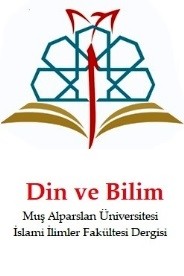Kur’ân’da İnne Edatının Kullanım Şekilleri ve Anlamı
Tefsir, Kur’ân, Edat, Ḥuruf-i Müşebbehe bi’l-Fiil, İnne
The Usage and Meaning of the Preposition of "Inne" in the Quran
Tafsir, Qur'an, Preposition, Huruf-i Müşebbehe bi’l-Fiil, İnne,
___
- Akdemir, Hasan. Belâgat Terimleri Ansiklopedisi. İzmir: Nil Yayınları. ts.
- Dinçer, Ferit. el-Keşşaf’ta Sarf Vezinlerinin Farklılıkları ve Anlam Üzerindeki Etkisi. Malatya: İnönü Üniversitesi, Sosyal Bilimler Enstitüsü, Doktora Tezi, 2019.
- Ebû Hayyân, Muhammed b. Yusuf, el-Endelûsî. el-Baḥru’l-muḥîṭ. thk. Âdil Ahmed Abdulmevcud & Ali Muhammed Mu‘avid. 8 Cilt. Beyrut: Dâru'l-Kütübi’l-ʿİlmiyye, 1413/1993.
- Ebû Ubeyde, Maʿmer b. el-Müsennâ et-Teymî el-Mısrî. Mecazu’l-Ḳur’ân. thk. Muhammed Fuad Sezgin. 2 Cilt. Kahire: Mektebetü’l-Hanci, 1381.
- Ezherî, Muhammed b. Ahmed. Meʿâni ’l-ḳıraat. thk. İyd Mustafa Derviş & Avd b. Hamd el-Kavzî. 3 Cilt. Riyâd: y.y., 1991.
- Ferrâ, Ebû Zekeriyyâ Yahyâ b. Ziyâd b. Abdillâh el-Absî. Meʿâni ’l-Ḳur’ân. 6 Cilt. Beyrut: ʿÂlemu’l-Kütüb, 1984.
- Hasan, Abbâs. en-Naḥv’ul-vâfî. Mısır: Dâru’l-Meʿârif, 3. Baskı, 1974.
- Hâşimî, Ahmed. Cevâhiru’l-belâġa fi’l-maʿânî ve’l-beyân ve’l-bedîʿ. Kâhire: Matbaʿatü medreseti vâlideti Abbâs Pâşa el-Evvel, 1905.
- Hilalî, Hâdî Atiyye Matar. el-Ḥurufu’l-ʿAmile fi’l-Ḳur’ân’i-l kerîm. Beyrut: ʿÂlemu’l-Kütüb, 1986.
- İbn Hâleveyh, Ebû Abdullah el-Huseyin b. Ahmed b. Hamdan. el-Ḥücce fi'l-ḳraati's-sebʿa. thk. Abdul’all Sâlim el-Mükrrem. Beyrut: Dâru'ş-Şürük, 1979.
- İbn Hişâm, Ebû Muhammed Abdullah Cemaluddin el-Ensarî. Şerhu şuzûru’ẕ-ẕeheb fî maʿrifeti kelâmi’l-ʿArab. Beyrut: el-Mektebetü’l-ʿAsriyye, 2006.
- İbn Hişâm, Ebû Muhammed Abdullah Cemaluddin el-Ensarî, Ḳaṭru’n-nedâ ve bellu’ṣ-ṣedâ, Beyrut: Dâru’l-Kütübi’l- ʿİlmiyye, 4. Basım, 2004.
- İbn Kuteybe, Ebû Muhammed Abdullah b. Müslim ed-Dîneverî. Müşkil’ul-Ḳur’ân. Beyrut: Müessesetü’r-Risâle, 2010.
- İbn Manzûr, Ebû’l-Fazl Cemâlüddîn Muhammed b. Mükerrem b. Alî b. Ahmed el-Ensârî. Lisânu’l-ʿArap, Kahire: Dâru’l-Meʿârif, 1119.
- İbn Usfur, Ebü’l-Hasen Alî b. Mü’min b. Muhammed b. Alî el-Hadramî el-İşbîlî. Şerhu cümeli’z-Zeccâcî. 3 Cilt. Beyrut: Dâru’l-Kütübi’l-ʿİlmiyye, 1998.
- İbn Zencele, Ebû Zür'a Abdurrahman b. Muhammed. Ḥüccetu'l-ḳıraat. thk. Saîd el-Efğanî). Beyrut: Müessesetü'r-Risale, 1997.
- Karaman, Hayrettin vd.. Kur’ân Yolu Meâli. 5 Cilt. Ankara: y.y., 2013.
- Kastamonî, Yahyâ Hilmî b. Hüseyin. Miṣbâḥu’l-iḫvân li-taḥariyyati’l-Ḳur’ân. İstanbul: Mahmutbey Matbaʿası, 1904.
- Kazvînî, Ebü’l-Meâlî Celâlüddîn el-Hatîb Muhammed b. Abdirrahmân b. Ömer b. Ahmed eş-Şâfiî, el-Îḍâh fî ʿulûmi’l-belâġa. Beyrut: y.y. 1993.
- Mâlekî, Ahmed b. Abdinnur. Raṣfu’l-mebânî fî şerḥi ḥurûfi’l-meʿânî. thk. Muhyiddin Ramazan. 2 Cilt. Dımaşk: Dâru’l-Kalem, 2002.
- Mekkî, Ebû Muhammed b. Ebî Tâlib Hammûş b. Muhammed el-Kaysî. el-Keşf ‘an vücühi'l-ḳıraat. Beyrut: Müessesetü'r-Risâle, 1997.
- Nehhâs, Ahmed b. Muhammed. Meʿâni’l-Ḳur’ân. thk. Muhammed Ali Sâbûnî. 6 Cilt. Riyad: Camiʿatü Ümmül Kurrâ, 1408/1988.
- Râzî, Ebû Abdillah Fahruddîn Muhammed b. Ömer. et-Tefsîru’l kebîr/Mefâtîḥu’l-ġayb. 32 Cilt. Beyrut: Dâru’l-Fikir, 1420.
- Süyûtî, Ebû’l-Fazl Celâlüddîn ‘Abdurraḥmân b. Ebî Bekr b. Muhammed. el-Behcetu’l-marḍiyye. Kahire: Dâru’s-Selâm, 2000.
- Şevkânî, Muhammed b. Ali b. Muhammed, Fetḥu’l-ḳadîr. Beyrut: Dâru’l-Meʿârife, 2007.
- Udayme, Muhammed Abdu’l-Halık. Dirasatun li üslubi’l-Ḳur’ân-il kerîm. 11 Cilt. Kahire: Dâru’l-Hâdîs, 1972.
- Zeccâc, Ebû İshâk İbrâhîm b. es-Serî b. Sehl el-Bağdâdî. Meʿâni’l-Ḳur’ân ve iʿrabüh. thk. Abdulcelîl Abduh Şelebî. 5 Cilt. Beyrut: ʿÂlemu’l-Kütüb. 1988.
- Zemahşerî, Ebû’l-Kâsım Mahmûd b. Ömer. Tefsîru’l-keşşâf ʿan Ḥaḳâiḳi ġavâmîḍi’t-tenzîl ve ‘uyûni’l-eḳâvîli fî vucûhi’t-te’vîl. thk. Âdil Ahmed Abdulmevcud & Ali Muhammed Mua’vvid. 6 Cilt. Riyad: Dâru’l-Âbikân, 1998.
- Yayın Aralığı: Yılda 2 Sayı
- Başlangıç: 2018
- Yayıncı: Muş Alparslan Üniversitesi
İbrahim YILDIZ, Çevirmen: İbrahim Yıldız
Hâlid b. Velîd’in Komutanlığı ve Azledilmesi
Hz. Ömer’in Teravih Namazıyla İlgili Uygulamasının Fakihlerin İhtilafındaki Rolü
Covid-19 Koronavirüs Salgını Sürecinde Yaşlıların Örselenen Onuru ve Hadislerde Yaşlıların Konumu
Kur’ân’da İnne Edatının Kullanım Şekilleri ve Anlamı
Muhteva Açısından Namazdan Sonra Yapılan Tesbîhât ve Zikirler
